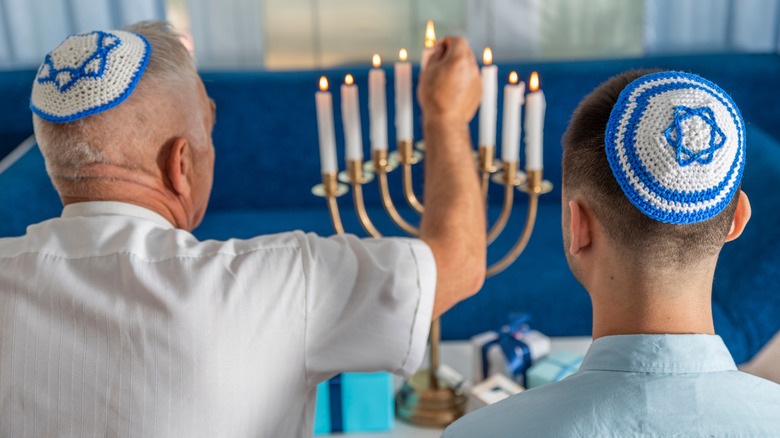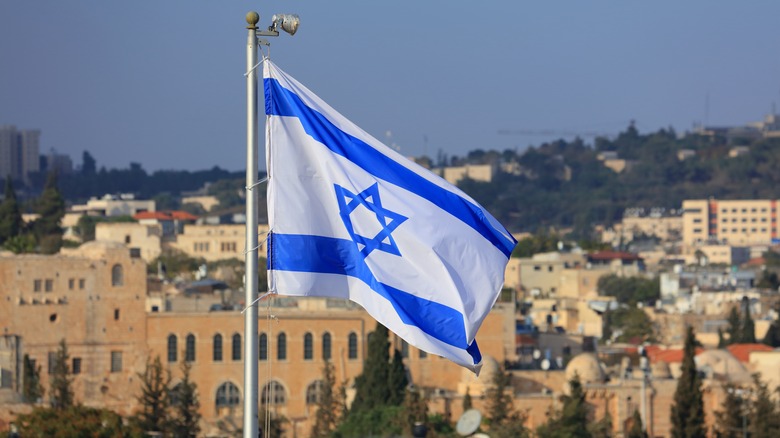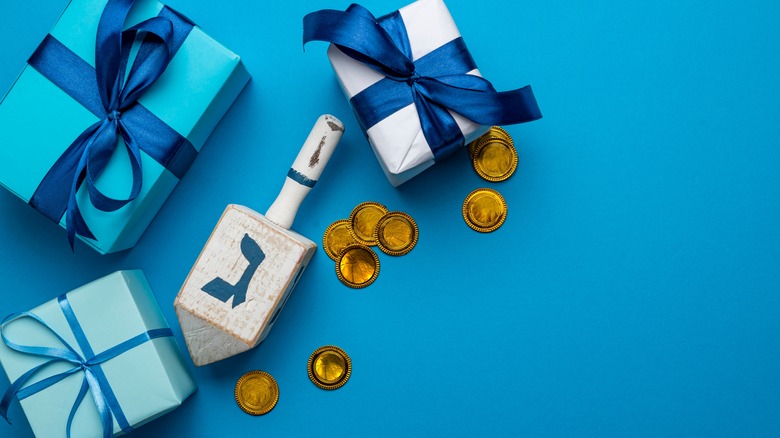Why The Color Blue Is So Closely Associated With Hanukkah Decorations
At minimum, when non-Jewish people think of Hanukkah they might imagine a vague version of the basics: something-something menorah (the nine-candled candelabra), something-something end of the year around Christmas time, and something-something ... blue? Yes, Hanukkah is one of those holidays that's easily recognized by its simplest artifacts, in the same way that Christmas equals Santa, presents, Christmas tree, etc. But of course, because Hanukkah is a holiday within Judaism — a 4,000-year-old religion with gobs of long-established traditions — the roots of its customs go much deeper than kitsch-like dollar-store plastic gold coins. The color blue, though? That's a recent addition.
As Time quotes professor of religion and American studies at Rowan University, Dianne Ashton, there's no specific place and time where someone sat down and said, "From today Hanukkah shall be full of blue." However, we might have everyone's go-to greeting card company — Hallmark — to thank for popularizing the color. This is especially true because the whole blue Hanukkah thing is chiefly an American occurrence.
This doesn't explain why anyone chose blue to begin with, however. For that, we've got to look to the year that blue started cropping up in conjunction with Hanukkah: 1948. That date ought to ring a bell for the history-savvy. Following the devastating events of World War II on the globe's Jewish population, 1948 saw the formation of the state of Israel, a Jewish national home. Israel's flag colors are white and the exact shade of Hanukkah blue.
Symbol of a holy life
Even though blue presumably got incorporated into Hanukkah because of the Israeli flag, blue has a far more ancient significance in Judaism. As My Jewish Learning explains, the Jewish tallit — prayer shawl — is blue and white. In fact, the flag of Israel kind of looks like a big, brightly colored tallit with a Star of David — a six-sided star — in the middle. And indeed, My Jewish Learning says that the original Israeli flag had darker colors, closer to tallit blue, but those colors were modified for practical purposes so they would be easier to see on the ocean.
Chabad says that the blue thread in the tallit goes back to the Torah itself — the first five books of the Bible. The Torah calls for a single thread of "tekhelet" — blue wool — to be woven into each corner of people's shawls. The color, which was a "hallmark of nobility," was possibly a by-product of a marine snail, but no one knows for sure. Chabad also says that blue crops up across multiple Jewish texts as a holy color.
Fast forward to 1860, per My Jewish Learning, the Austrian poet Ludwig August Frankl wrote about a blue and white Jewish flag. White represented "the radiance of the priesthood," and blue "the splendors of the firmament," directly inspired by the tallit. The whole flag symbolized the "religious and ritual symbolism of Jewish life guided by precepts of the Torah."
Colors of freedom, new and old
Aside from the traditional, historical significance of the color blue with Judaism, the blue of the Israeli flag most likely connected to Hanukkah — as opposed to another Jewish holiday — because of Hanukkah's role as a holiday of independence. As Reform Judaism explains, Hanukkah might not be as old as many other elements of Judaism, but does go back to 168 B.C.E. That year, the Syrian king Antiochus Epiphanes sacked the Jewish temple at Jerusalem — the Second Temple, built 520 B.C.E. — and tried to get the Jews in the city to convert to non-Jewish practices. Enter the Maccabees, a group of rebels who rose to overthrow the Syrians.
The Maccabean revolt illustrates the Jewish "refusal to submit to the religious demands of an empire," as Reform Judaism says. It's this story that Hanukkah celebrates, and it's this story that some heard echoed in the Jewish triumph of independence following World War II when the state of Israel was formed in 1948. The formation of Israel itself, as Time says, is like an updated version of that older tale, which draws nationalistic attention to the flag and might be responsible for grafting its colors onto a newer holiday of independence: Hanukkah.
Interestingly enough, Time says that to Jews within Israel Hanukkah has less importance than Israel's actual independence day, May 8. And as stated, for those countries outside of Hallmark's pop cultural influence, blue never caught on as a Hannukah color, anyway.


